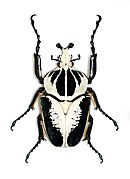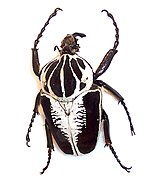Goliathus regius
| Goliathus regius | |
|---|---|
 | |
| Goliathus regius | |
| Scientific classification | |
| Domain: | Eukaryota |
| Kingdom: | Animalia |
| Phylum: | Arthropoda |
| Class: | Insecta |
| Order: | Coleoptera |
| Family: | Scarabaeidae |
| Genus: | Goliathus |
| Species: | G. regius |
| Binomial name | |
| Goliathus regius Klug, 1835 | |
| Synonyms | |
| List
| |
Goliathus regius, the Royal Goliath beetle,[6] is a species of beetles of the family Scarabaeidae.[7][8]
Description[edit]
Goliathus regius is very similar to Goliathus goliatus in both structure and colour characters.[4] It is one of the largest species of the genus Goliathus, with a body length of 50–115 millimetres (2.0–4.5 in) in males and of 56–82 millimetres (2.2–3.2 in) in females. The body is broad and flat. Elytra are whitish with a complex pattern of black markings, and the pronotum (thoracic shield) has a large black longitudinal stripe. The head bears a black Y-shaped horn in males, used in battles with other males. Legs are long, powerful, black. Females have two sharp spikes on the outside of the tibiae. Despite its large body, these beetles fly well. They have a large and membranous secondary pair of wings. When not in use, these wings are kept completely folded beneath the elytra. These beetles feed primarily on tree sap and fruits.[6]
Life cycle[edit]
The larvae live in the soil and need the protein-rich diet, because they grow very quickly. In captivity they may feed on commercial cat and dog food. Even under optimum conditions, the larvae take about 4 months to mature fully, which corresponds to the duration of the rainy season. Larvae can reach a length of about 130 millimetres (5.1 in) and a weight of about 100 grams (3.5 oz). When maximum size is reached, the larva constructs a pupal chamber in which it will undergo metamorphosis (pupation) to the adult state. In this stage they spend most of the dry season. The adult does not come up before the rain comes. In captivity the adults can live over a year, but in the wild life is probably much shorter.[9]
Distribution[edit]
This species is present in western equatorial Africa, in Equatorial Guinea, Sierra Leone, Ivory Coast, South Burkina Faso, Ghana, Togo, Benin (Dahome), Nigeria and Liberia.
Gallery[edit]
- Goliathus regius, male, Musée d'Histoire Naturelle de Lille
- Goliathus regius
- Mouse and Goliathus regius. Field Museum.
References[edit]
- ^ Westwood J.O. (1837) Illustrations of exotic entomology, containing upwards of six hundred and fifty figures and descriptions of foreign insects, interspersed with remarks and reflections on their nature and properties, Drury's Exotische Insecten 2(3):1-93
- ^ MacLeay W.S. (1838) On the Cetoniidae of South Africa. Smith A.:Illustrations of the zoology of South Africa; consisting chiefly of figures and descriptions of the objects of natural history collected during an expedition into the interior of South Africa, in the years 1834,, Smith, Elder & Co. London 3:3-52
- ^ Castelnau F. (1840) Histoire Naturelle des Insectes Coléoptères. Avec une introduction renfermant L'Anatomie et la Physiologie des Animaux Articulés, par M.Brullé, P.Duménil. Paris 2:1-564
- ^ a b Wiebes, J.T. (1968) Catalogue of the Coleoptera Cetoniidae in the Leiden Museum 1. Goliathus Lamarck, sensu lato. Zoologische Mededelingen 43: 19-40.
- ^ a b c d e f g h i j k l m n o p q r s t u Endrödi S. (1960) Die arten und abberationen der gattung Goliathus Lam II, Folia Entomologica Hungarica, Budapest 13(22):467-508
- ^ a b "Goliathus regius in Natural World". Archived from the original on 2014-10-30. Retrieved 2015-01-17.
- ^ Klug J.C.F (1835) Verzeichniss von Thieren und Pflanzen, welche auf einer Reise um die Erde gesammelt wurden von A.Erman. V.Insekten (Coleoptera), Berlin G.Reimer :27-50
- ^ Scarabs: World Scarabaeidae Database. Schoolmeesters P., 2011-05-30
- ^ Karl Meyer Goliathus Breeding Manual Archived 2020-11-07 at the Wayback Machine


 French
French Deutsch
Deutsch

